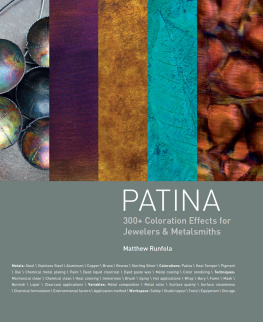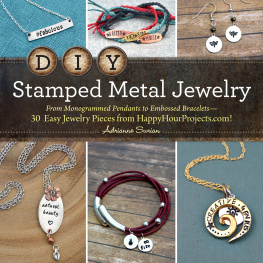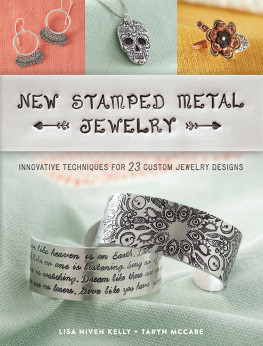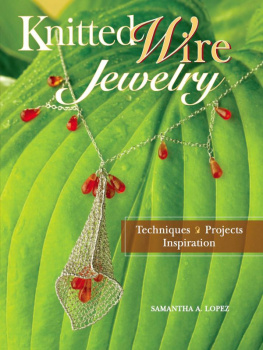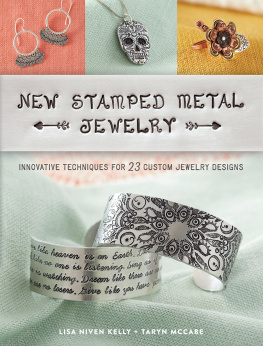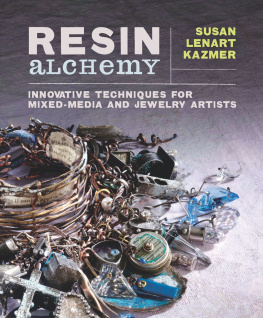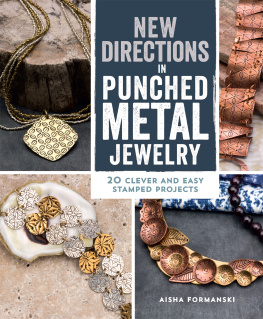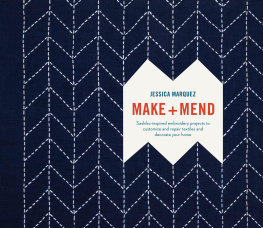PATINA
300+ Coloration Effects for
Jewelers & Metalsmiths
Matthew Runfola
Contents
Introduction
In 2003 I was in my second year of what now has been a 12-year teaching position at the Evanston Art Center, located just north of Chicago, Illinois. The Metal Sculpture Department had a rebirth of sorts, and we were looking to expand the courses we offered our students. Most in our shop were working with fabricated steel and looking for finishing alternatives to rust, paint, or bare metal. I brought in Ron Young of Sculpt Nouveau to teach a ferrous metal finishing workshop at the school. This is how I became involved in the world of metal patination.

For me, patination is the right balance of science and art and it satisfies my dual-minded persona. Though I trained as a mechanical engineer I decided to delve into art full-time to better fulfill my creative ambitions. I enjoyed playing mad chemist with the various colorants while applying them in a meaningful, artistic manner to my objects. I immersed myself in the field: reading, sharing with other artists, and experimenting. For a time, metal patination was the most important part of my work. My fabricated forms were merely a vehicle or surface to display the colorations on. I became, and still am, a painter with chemicals. I love the ability to be expressive not just with the form, but with the finish as well. In 2004 I launched Runfola Studios, which focuses on patinated contemporary metal furnishings and accessories.

MATTHEW RUNFOLA
From above
Color and color pattern take center stage on this wall hanging (90 42in/229 107 cm), transforming a static two-dimensional triptych into a flowing continuum. The use of masked and layered patinas, pigments, and dyes give visual depth and a sense of movement to the panels.
Today, I continue to teach, create, exhibit, and sell both sculptural and functional objects and perform metal finishing services for other artists and artisans. I teach metal finishing workshops that focus on the fundamentals of the patination process, with methods to personalize the colorations to the object at hand. I hope I have achieved those same goals in this book. Happy patinating to you all!

About this book
Structure
There are a multitude of different patination and coloration effects that can be applied to metals. This part features examples of work by the best jewelers and metalsmiths working with colored metals, and compares their methods and approaches.
An in-depth discussion on the tools and equipment used for metal colorations, and how to set up a safe and efficient workspace.
This chapter delves into the many factors influencing the metalsmiths decision about what coloration to use.
Numerous elements can influence the overall outcome of the coloration result within the basic process chosen. Runfola covers the variables that can be controlled, easily or not so easily, so the jeweler can obtain the overall look and feel he/she requires. The base metal composition and surface quality, the coloration and application methods chosen, and the final metal protection method are covered.

Different coloration methods are compared in this chapter to enable choices to be made.
This section discusses and compares the most common, accessible coloration techniques, including patinas, pigments, dyes, and heat tempering, with notes on durability of each finish. The core techniques for applying coloration to the metal surface are explained using large format step-by-step pictures. Health and safety is an important aspect of these techniques and precautions that should be taken for each technique are fully explained.

This is a comprehensive guide to applying reactive and non-reactive colorants. Using step-by-step photography, the author demonstrates surface preparation and various hot and cold application techniques.
The patination directory chapter contains more than 300 colorations and is organized firstly by metal (nine in total) and secondly by general color. The numbers following each coloration name cross-refer to a recipe formula. The complete listing of formulas can be found on .

This section contains a listing of all the colorants used in the tile directory. Colorants are a combination of simple chemical formulas, branded pre-mixes, and household ingredients to allow for a broad spectrum of metal colorations on each of the seven metal families.

Each metal has an introductory essay that describes the metals use in arts and crafts, both historically and in contemporary practice.

Within each metal category, tile samples are organized by color.
Chapter 1
Metal coloration in context
Jewelers and metalsmiths have always considered color an important aspect of their work. Coloration, whether it is simply the raw metal surface, or achieved through natural oxidation or chemical patination, can be used to enhance the form. This chapter showcases a collection of objects in various metals demonstrating the beauty of metal coloration.
Coloration gallery
Jewelers and metalsmiths have always had a strong relationship with color. From the raw beauty of precious metals to the natural colorations available through patination, metal artists have used color to affect the viewers perception of the object. Contemporary artists are no different in their thinking, but may push traditional norms. Today, jewelers and metalsmiths are continually broadening their color palettes and methods used for coloring across a larger spectrum of materials. However, color has been, and will always be, used as a means for expression.
As the cost of precious metals continues to rise (namely, silver), many metal artists are looking to alternative metals and materials for construction. Jewelers and metalsmiths are increasing their use of less expensive copper, brass, bronze, aluminum, stainless steel, and steel. The use of these non-precious materials opens up the possibility to employ more surface color to add to the objects expressiveness. Not only are there more reactive colorations available with some of these metals, but there is less risk in allowing the surface color to override the material in importance. This is not as true with gold and silver, where the perceived status of the work comes in large part from identifying the precious metal itself.

